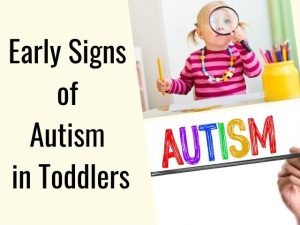1. Let Kids Lead: Allow your children to choose their own goals, as it truly boosts their engagement and sense of accomplishment. .
2. Celebrate Progress Together: Find fun ways to acknowledge your child’s efforts, which can be as simple as a high five or a special treat.
3. Turn Setbacks into Lessons: It’s important to remind our kids, and ourselves, that not reaching a goal isn’t a failure but a learning opportunity.
As a mother to a lively 6-year-old and a former teacher, I’ve seen firsthand how goal setting can be a transformative tool both at home and in the classroom. Drawing from my experiences, I’ve found ways to blend educational strategies with the nurturing environment of home, making goal setting activities a fun and rewarding journey for my child.
Why use goal setting activities at home
Here’s some reason for using goal setting activities at home:
- Gives them a sense of purpose which improves confidence
- Teach them the importance of planning ahead and critical thinking
- Fostering a can-do attitude from a young age
- Motivate kids to achieve smaller goals on a regular basis
As adults, we need to encourage children to believe that they can dream big and if they are persistent enough they can achieve it.
So how do we teach children to set goals? Let’s go through some fun goal setting activities to help them understand how this can benefit them.
Goal setting activities at home
1. Let your child create a “wishlist”
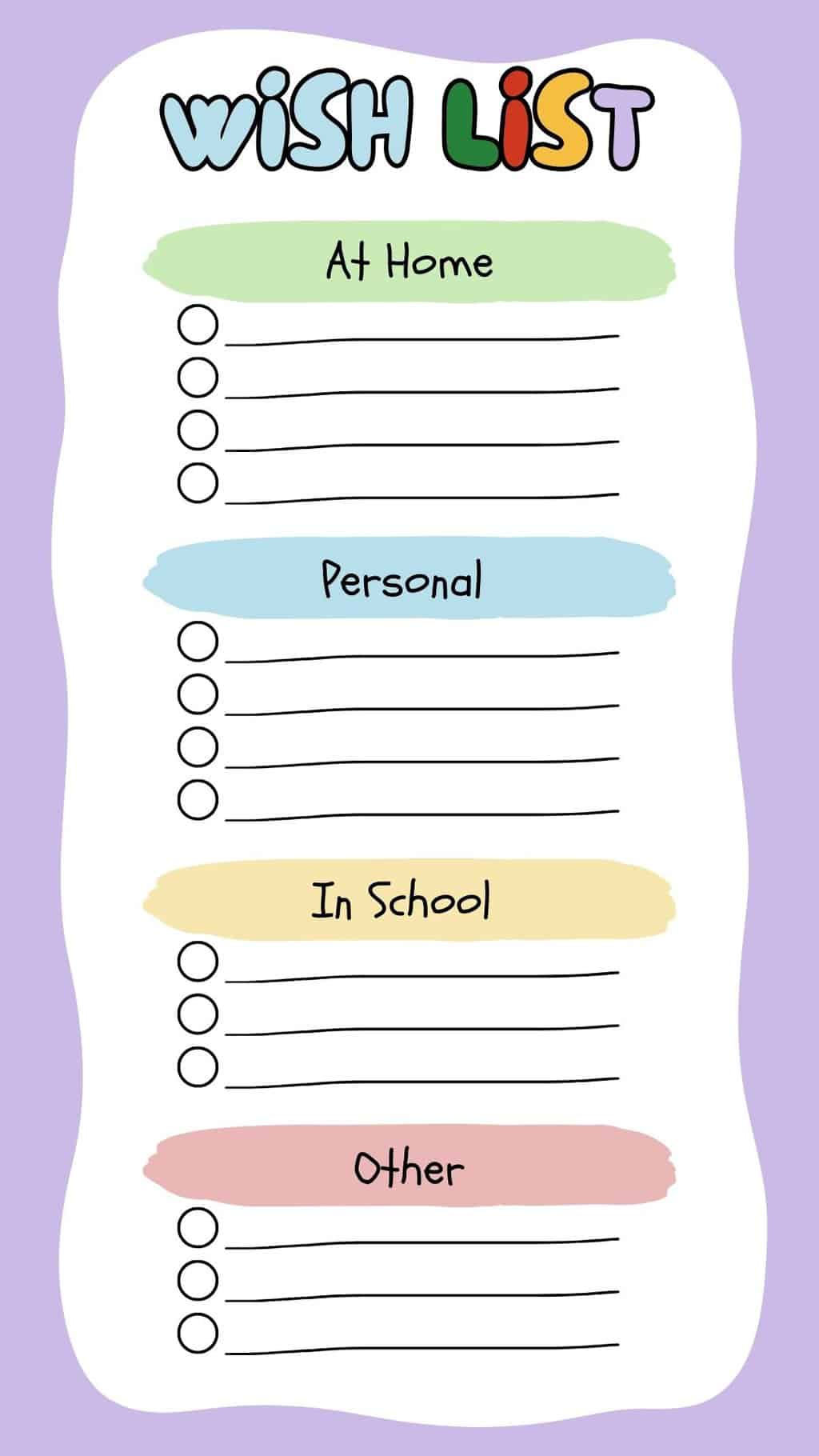
In our household, the “wishlist” has become a cherished tradition. It’s a simple yet powerful way for her to articulate her aspirations and learn the value of setting goals.
You can start sitting down with a colorful notebook and some of their favorite pens. Together, brainstorm different categories for their goals.
For example, we came up with headings like ‘Academic’, ‘Personal’, ‘Fun Skills’, and ‘Helping Out at Home’. The categories themselves were a great conversation starter about the different areas she would like to work on.
Then, the real magic happened: she took the lead in listing her wishes under each category. She wrote down goals like ‘Read a new storybook every week’, ‘Learn to tie shoelaces’, and ‘Help Mom with setting the dinner table’.
It was important for me to step back and let her take ownership of this wishlist. This autonomy, I believe, is what truly motivates her to pursue these goals
The joy she gets from ticking off a completed goal is immense. And the goals were refreshingly simple, yet meaningful.
For instance, reading for 10 minutes before bed has become our special bonding time, and seeing her make her bed every morning with such pride is a reminder of how even small goals can foster a sense of responsibility.
Keep in mind that the wishlist does not have to be something really big. It can be a small idea, for example, reading 10 minutes a day, making their bed in the morning, etc.
Use the goal-setting worksheet, below to help your child visualise their goals.
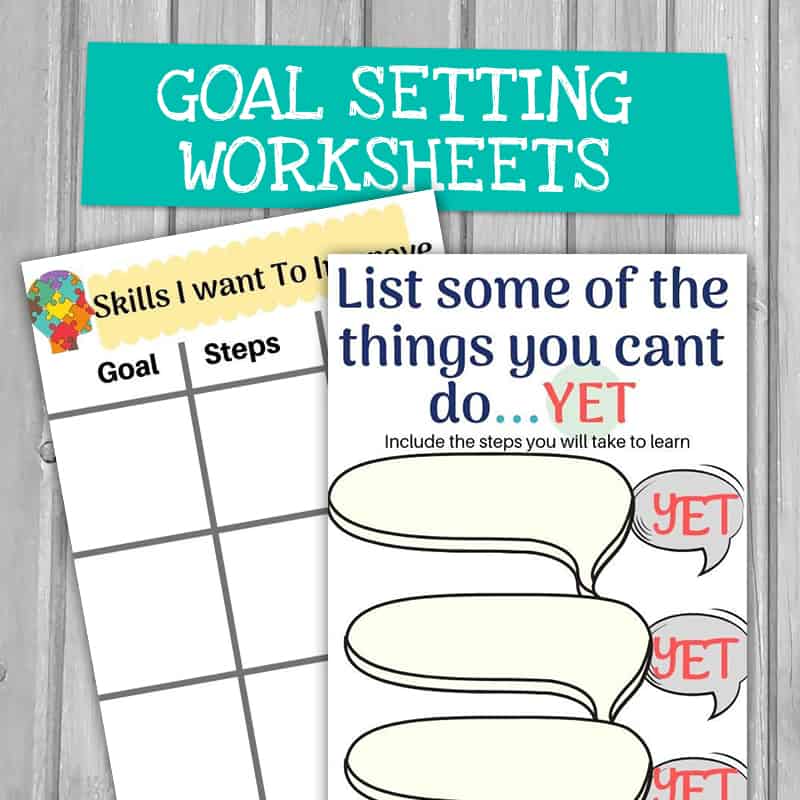
2. Creating a Vision Board Together:
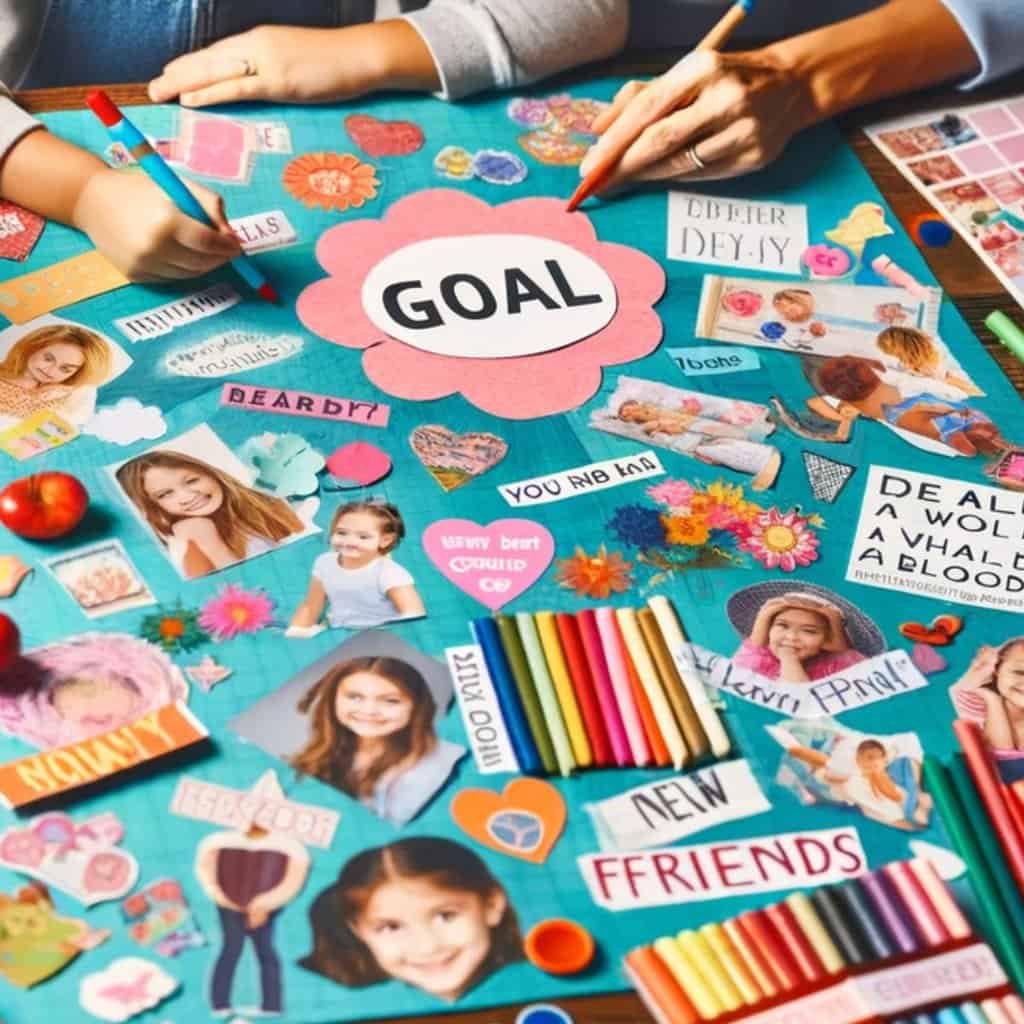
At the beginning of the school year, my little one and I sat down with a bunch of magazines, stickers, and markers to create a vision board.
We talked about what she hoped to achieve this year – like reading a whole book by herself or making a new friend. It was a delightful way to visually map out her dreams and goals.
2. Create small goals
Like I mentioned earlier start with smaller goals. If the goals are very big and need years to be achieved your child will not be motivated to go after it.
Smaller, measurable and achievable goals are more inspiring for children. Don’t force your child to go after something that is unattainable.
Start with something they can achieve by the end of the week. This will give them the confidence to follow through on their goals.
Keep in mind, that every child is different. While some may prefer smaller goals, there are children that go after bigger ones. Define the goals based on what you think is best for your child.
3. Use a positive reinforcement chart
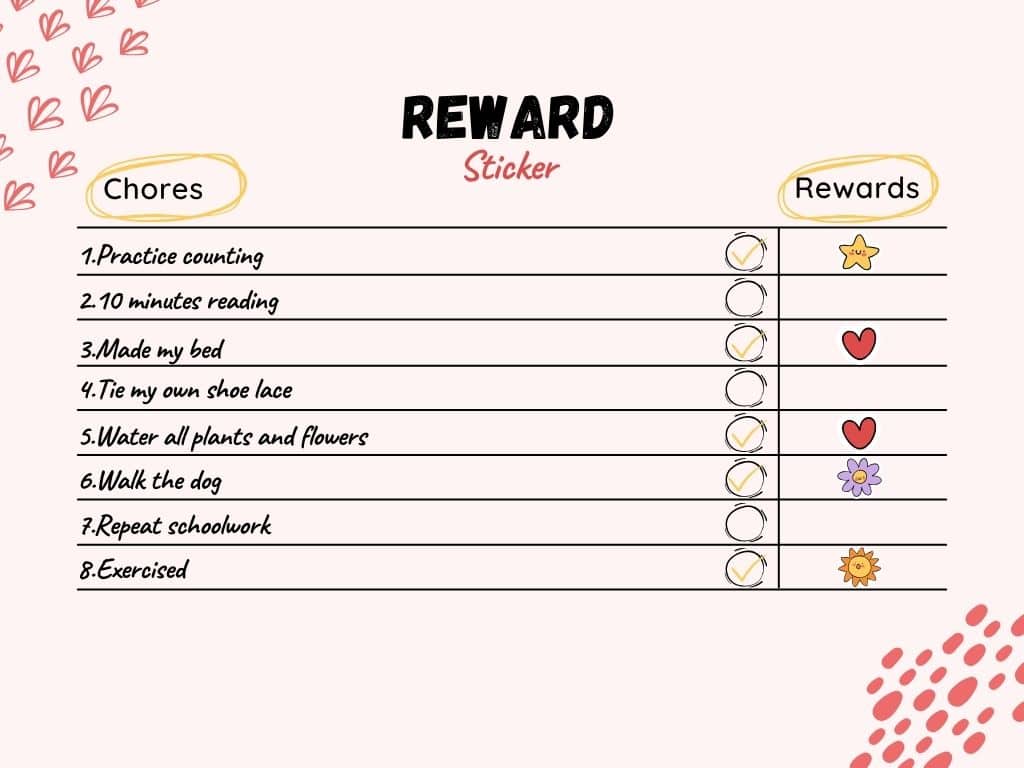
Reward chart is a good reminder for children on how far they have come with achieving their goals.
In our home, we’ve found a fun and effective way to encourage my daughter’s progress towards her goals – a Positive Reinforcement Chart.
This colorful chart, which we created together and it is printed and kept on her study table.
Every time she dedicates 10 minutes to reading – a goal we decided on together – she places a shiny star sticker on the chart.
This visual representation of her hard work is incredibly motivating for her. We’ve set up a system where accumulating these stars leads to a special reward. Her favorite is getting to pick the next movie for our family movie night, a choice she makes with great enthusiasm and thought.
This chart isn’t just about earning rewards; it’s a tangible way for her to see her progress and feel proud of her efforts.
Using a chart like this is a lovely way to connect with your child and celebrate their successes together.
Goal Setting activities at School
Drawing from my experience as a teacher, I’ve seen how goal setting can make a significant impact on students’ learning and personal growth. Here are three simple yet effective goal-setting ideas that I’ve found to be particularly successful in the classroom:
1. Personal Achievement Booklets:
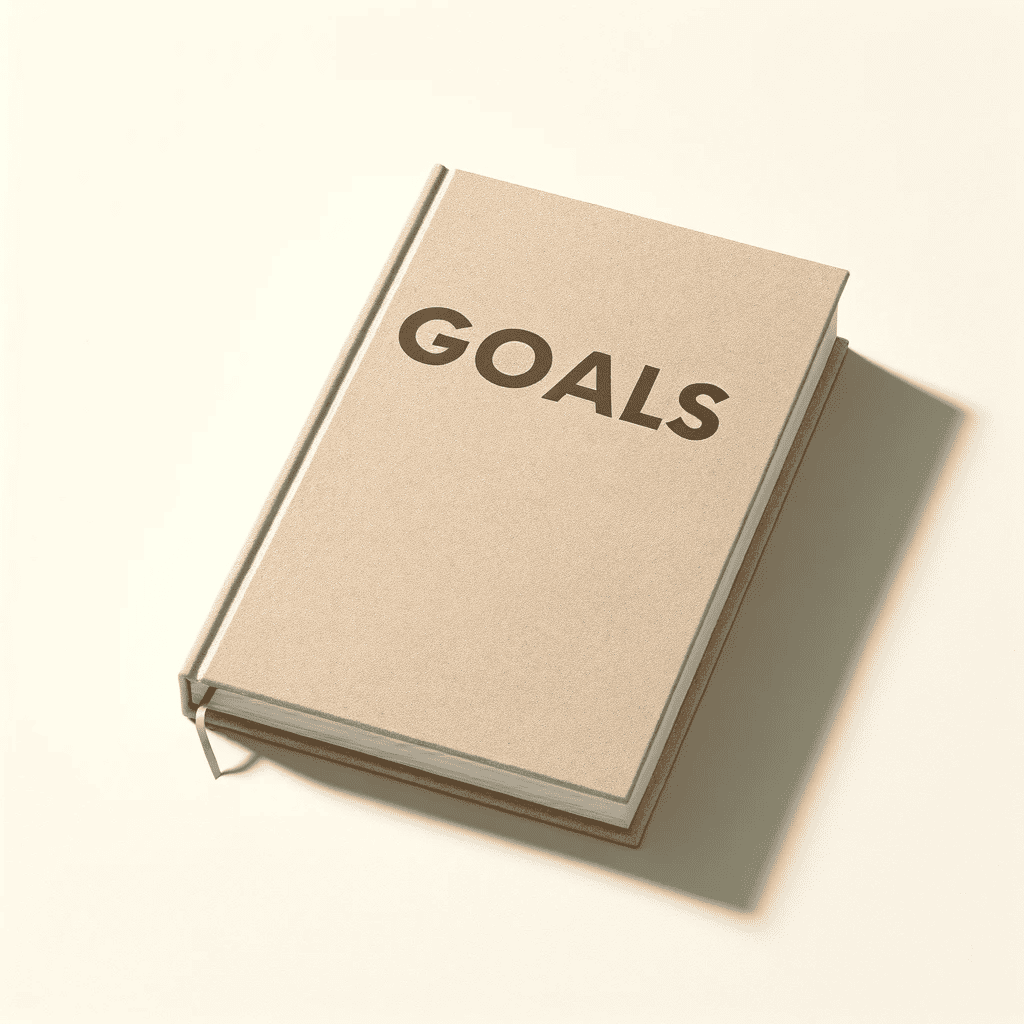
Each student receives a booklet at the beginning of the school year where they can set and track their personal and academic goals.
For instance, a student might set a goal to improve their reading comprehension or to participate more in class discussions.
These booklets are reviewed periodically, allowing students to reflect on their progress and set new goals. This approach not only encourages self-awareness but also fosters a sense of accomplishment as students see their own growth over time.
2. Classroom Goal Tree:
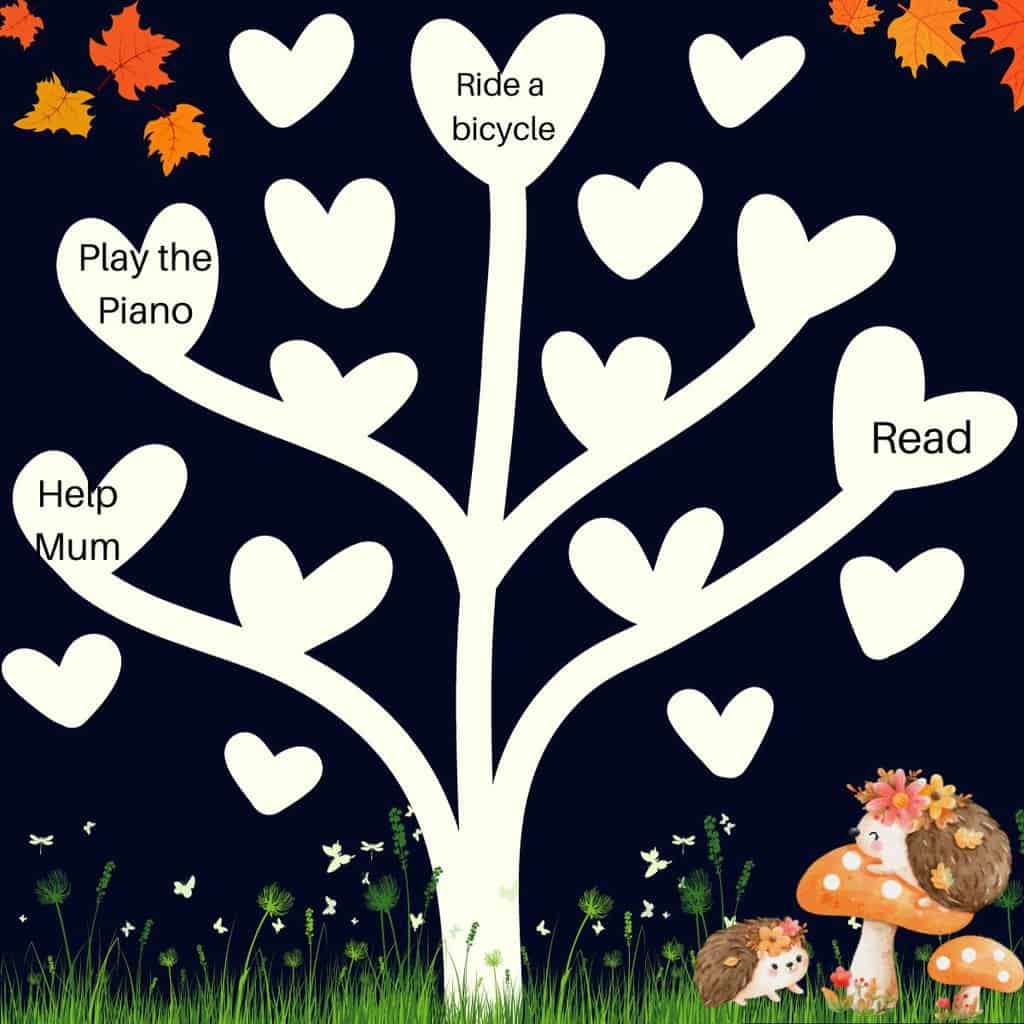
Each leaf on the tree represented a goal set by a student.
These could be short-term goals like completing a project or long-term goals like mastering a difficult concept. As students achieved their goals, they would add a colorful fruit or flower sticker next to their leaf.
This visual and collaborative approach made goal setting a shared and supportive experience, encouraging students to cheer on their classmates and work towards their own goals.
3. Weekly Goal Setting and Reflection Sessions:
Every Monday, we dedicated a small portion of time for students to set a goal for the week. These goals were often simple and achievable, like turning in all homework on time or helping a fellow classmate with a challenging task.
On Fridays, we would reflect on these goals, discussing what was achieved and what challenges were faced.
This routine helped inculcate a habit of regular self-evaluation and adjustment, crucial skills for personal and academic success.
These activities not only helped in academic improvement but also played a crucial role in developing life skills such as planning, organization, and self-evaluation. As a teacher, it was fulfilling to see how these simple goal-setting exercises could make such a positive impact on my students.
4. Set SMART goals for students
SMART goals are a highly effective framework for setting clear and achievable objectives.
The acronym SMART stands for Specific, Measurable, Achievable, Relevant, and Time-bound. Here’s a detailed look at each component and how it can be applied in a classroom setting:
- Specific: Goals should be well-defined and clear. In a classroom, this means helping students articulate precisely what they want to achieve. For example, instead of a vague goal like “get better at math,” a specific goal would be “improve my grade in algebra from a B to an A.”
- Measurable: Goals need criteria for measuring progress. This helps students stay on track and meet their targets. In the classroom, a measurable goal could be, “Read 20 pages of a novel each week,” which provides a tangible way to track reading progress.
- Achievable: Goals should be realistic and attainable. While it’s great to encourage students to aim high, their goals should be within reach based on their current abilities and resources. For instance, setting a goal to complete all homework assignments on time for a month is challenging but achievable.
- Relevant: Goals should be relevant to the student’s interests, needs, and larger educational objectives. In the classroom, this means aligning goals with what they are learning or what they aspire to achieve in the future. For example, if a student is interested in science, a relevant goal could be to complete a science project or participate in a science fair.
- Time-bound: Every goal should have a deadline or a timeframe. This adds a sense of urgency and helps students focus their efforts. A time-bound goal in a classroom could be, “Prepare for the upcoming history test in two weeks.”
Things to consider when setting goals with children
1. Talk about the importance of their goals
Your child need to understand “WHY” they need to work towards their goals.
WHY are the goals important? And the purpose of the goal.
In order to get them excited about the goals they need to know the “WHY”.
Whenever possible think about the extension of the goal. What this means is that besides it being for a personal gain, find a reason how the goal can benefit others.
For instance, your child decides to learn to code so they can create their own video game. It will be helpful if you can extend that thought into something like:
“I want to learn to code so I can create a video game so that all my friends can play together”
Help your child extend that thought by asking them questions like “How will this goal help others?”
By finding a bigger purpose to their goals your kids will be inspired to work towards it. Also, don’t forget you are teaching them kindness at the same time.
2. What if goals were not achieved?
It is best to plan for obstacles ahead so children don’t lose their motivation.
We always ensure that the goals we set are within reach but still challenging. For instance, completing a small art project over the weekend – it’s achievable but also teaches her the joy of seeing a task through to completion.
But what if the goals are not achieved? For example, if you know you will be taking a summer break or be going out for the weekend then include that in the weekly goal. This way your child knows that for that week the goal might not be achieved.
If a goal is not attained because they need more time than anticipated then include that in their potential obstacles. A child can give up on something they set to do just because they need more time but do not have the patience for it.
Let them know the importance of perseverance and how obstacles and failures are also part of learning.
Summary
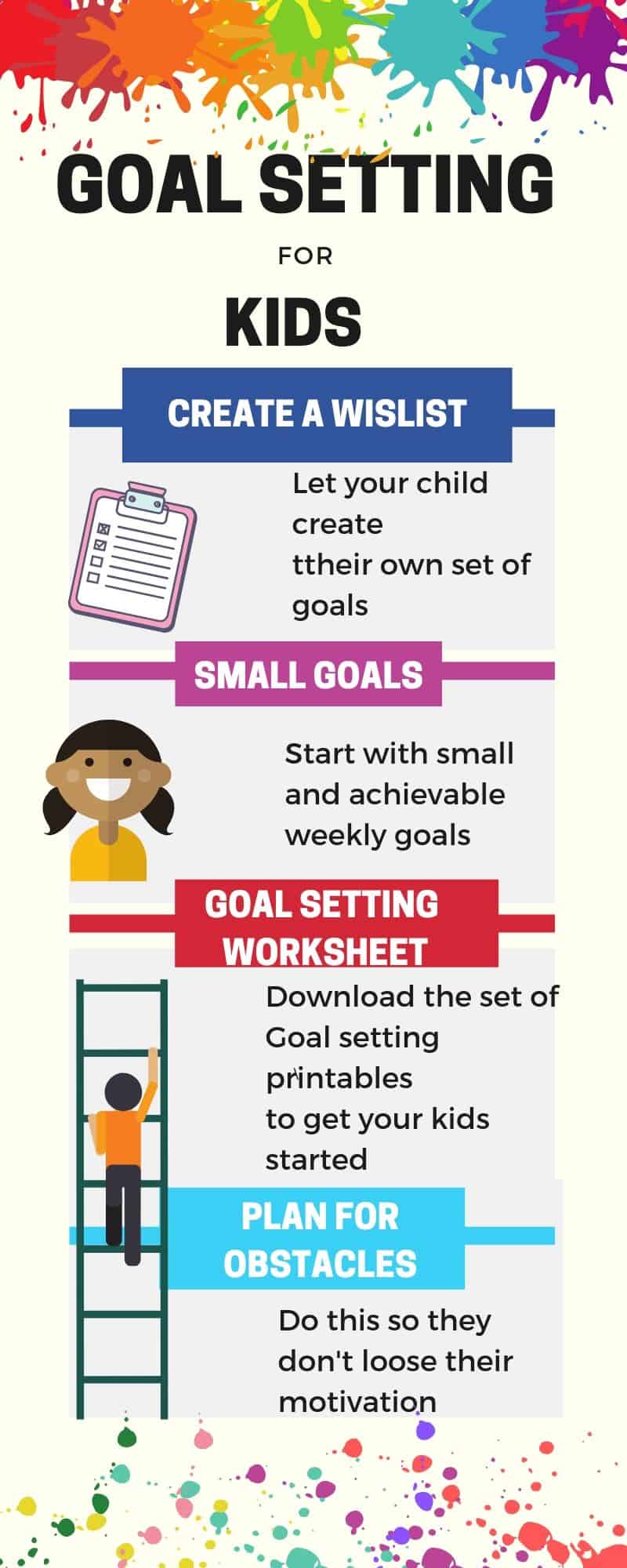
Use the Goal Setting Worksheets and take some time out to discuss with your child the goals they would like to accomplish for the rest of the year.
Step 1 : Let your child create their own wishlist
Step 2 : Create small goals
Step 3 : Discuss the importance of the goals with your kids
Step 4: Think about potential obstacles
Step 5: Share inspirational failure stories with your kids
Step 6 : Reward your kids with a job well done.
Was this helpful?
Good job! Please give your positive feedback
How could we improve this post? Please Help us.



